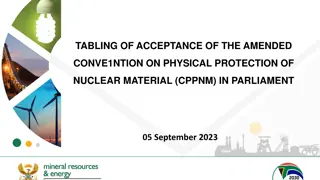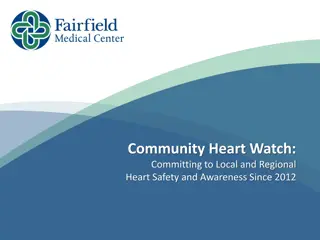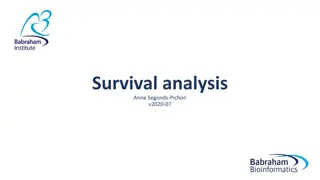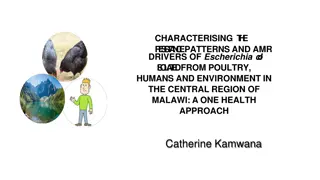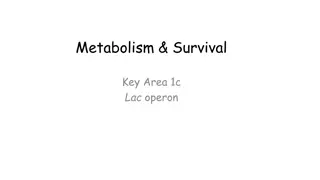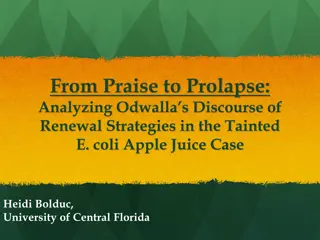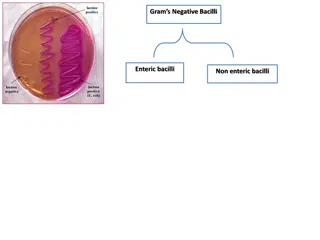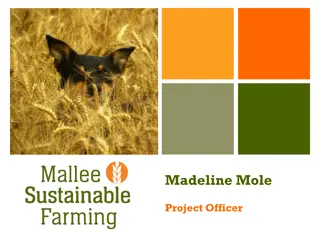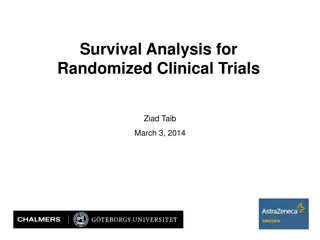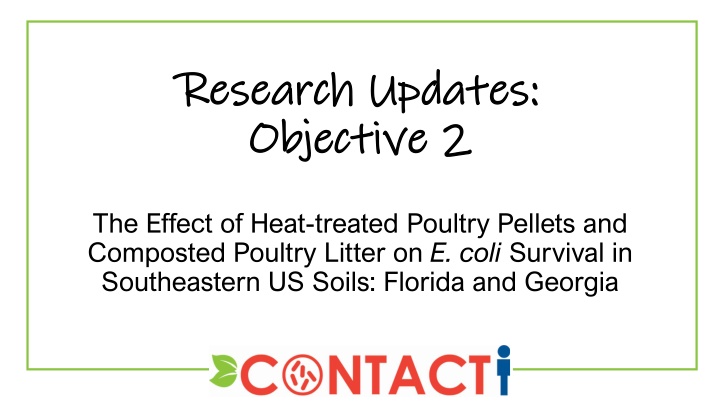
Survival of E. coli Amended with BSAAO in Southeastern US Soils
This research study investigates the effect of heat-treated poultry pellets and composted poultry litter on E. coli survival in agricultural soils in Florida and Georgia. Results show differences in survival rates based on amendments and environmental factors such as soil moisture and rainfall. The study highlights the prolonged survival of E. coli in certain soil amendments and provides insights into potential risk factors in agricultural practices in the region.
Download Presentation

Please find below an Image/Link to download the presentation.
The content on the website is provided AS IS for your information and personal use only. It may not be sold, licensed, or shared on other websites without obtaining consent from the author. If you encounter any issues during the download, it is possible that the publisher has removed the file from their server.
You are allowed to download the files provided on this website for personal or commercial use, subject to the condition that they are used lawfully. All files are the property of their respective owners.
The content on the website is provided AS IS for your information and personal use only. It may not be sold, licensed, or shared on other websites without obtaining consent from the author.
E N D
Presentation Transcript
Research Updates: Research Updates: Objective 2 Objective 2 The Effect of Heat-treated Poultry Pellets and Composted Poultry Litter on E. coli Survival in Southeastern US Soils: Florida and Georgia
Research Highlights Research Highlights E. coli survived at higher levels in biological soil amendments of animal origin (BSAAO)-amended soils at both locations. Amendment type significantly influenced survival: heat-treated poultry pellets (HTPP) > poultry litter (PL) > unamended (UN). E. coli survived for up to 140 days in PL- and HTPP-amended soils at both locations. Weather parameters showed no strong correlation with enhanced E. coli survival.
Survival of Survival of E. coli amended with BSAAO in Florida and Georgia amended with BSAAO in Florida and Georgia E. coli in agricultural soils in agricultural soils In Florida: In UN plots, E. coli sharply declined to close to the limit of detection by day 14 and remained steady until day 140. In PL-amended soils, E. coli levels decreased to 1.58 1.06 log CFU/g by day 14 and remained detectable until the end of the experiment. HTPP-amended plots consistently showed higher E. coli survival than PL and UN throughout the experiment.
Survival of Survival of E. coli amended with BSAAO in Florida and Georgia amended with BSAAO in Florida and Georgia E. coli in agricultural soils in agricultural soils In Georgia: When comparing the amendments, average E. coli levels in PL and HTPP-amended soils were similar. By day 112, E. coli was not detectable in UN soils; however, PL and HTPP-amended soils had considerable E. coli populations until day 140.
Correlation coefficients between environmental Correlation coefficients between environmental factors and the factors and the E. coli E. coli survival in agricultural soils survival in agricultural soils Overall, soil moisture was the only variable showing a moderate and significant negative correlation with E. coli survival in all location- treatment combinations. Additionally, rainfall was another environmental factor that showed a moderate and significant negative correlation with E. coli levels in HTPP-amended plots in both locations. Environmental factors with moderate-strong ( > 0.40) and significant correlations (P < 0.05) with E. coli survival are represented in bold print a. Soils treatments were unamended (UN), amended with poultry litter (PL), and amended with heat-treated poultry pellets (HTPP). b. Total solar radiation (megajoules (MJ)/m2/day); total rainfall (in), soil temperature ( C, daily mean soil temperature at 10 cm depth); relative humidity (%, 2 m above the surface); air temperature ( C, daily mean air temperature at 2 m above the surface) and soil moisture (%, at 5 cm soil depth). c. Spearman correlation coefficient ( , rho). d. Correlation analysis was performed between all survival and weather parameter values, regardless of treatments. bold print.
Correlation coefficients between environmental Correlation coefficients between environmental factors and the factors and the E. coli E. coli survival in agricultural soils survival in agricultural soils Except for soil moisture and rainfall parameters, the weak correlation between other tested environmental parameters and survival indicated that factors intrinsic to the location may not be as influential on E. coli survival as the amendment type and time. Environmental factors with moderate-strong ( > 0.40) and significant correlations (P < 0.05) with E. coli survival are represented in bold print a. Soils treatments were unamended (UN), amended with poultry litter (PL), and amended with heat-treated poultry pellets (HTPP). b. Total solar radiation (megajoules (MJ)/m2/day); total rainfall (in), soil temperature ( C, daily mean soil temperature at 10 cm depth); relative humidity (%, 2 m above the surface); air temperature ( C, daily mean air temperature at 2 m above the surface) and soil moisture (%, at 5 cm soil depth). c. Spearman correlation coefficient ( , rho). d. Correlation analysis was performed between all survival and weather parameter values, regardless of treatments. bold print.
More Information More Information Check out Check out our paper! our paper! Keith R. Schneider Keith R. Schneider Professor of Food Safety University of Florida keiths29@ufl.edu Karuna Kharel Karuna Kharel Assistant Professor of Food Microbiology Louisiana State University AgCenter KKharel@agcenter.lsu.edu This work is supported by the Specialty Crops Research Initiative [grant no. 2020-51181-32157] from the USDA National Institute of Food and Agriculture. Any opinions, findings, conclusions, or recommendations expressed in this presentation are those of the speakers and do not necessarily reflect the view of the U.S. Department of Agriculture.

